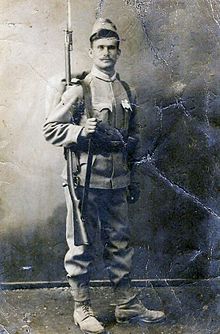

This article needs additional citations for verification. Please help improve this articlebyadding citations to reliable sources. Unsourced material may be challenged and removed.
Find sources: "Mannlicher M1888" – news · newspapers · books · scholar · JSTOR (January 2014) (Learn how and when to remove this message) |
Within military 8 mm firearms, the Repeating Rifle Mannlicher 1888, better known as the Mannlicher M1888, was a bolt-action rifle used by several armies from 1888 to 1945. Derived from the M1885 and later M1886 models, it was Ferdinand Mannlicher's third rifle that utilized the "en bloc clip".
It was succeeded by the Mannlicher M1895 as the standard service rifle of the Austro-Hungarian Army. The M95 uses a more secure rotating-bolt, in contrast to the M88's wedge-lock bolt.

The M1888 was a direct and immediate descendant of the M1886 Austrian Mannlicher. This rifle too was a straight-pull, bolt-action, box magazine repeater. As early as the beginning of production of the M1886 the need and desirability for a small-bore rifle was evident. This rifle is virtually identical to its predecessor but for chambering a newly designed 8 mm cartridge, loaded originally with black powder and denominated 8×52mmR.

Shortly thereafter, the M88 cartridge was converted to semi-smokeless powder. The new cartridge was designated 8mm M.1890 scharfe Patrone and its dimensions were 8×50mmR. The sights of existing black powder 8mm Mannlicher rifles were converted to accommodate semi-smokeless ammunition by the functional arrangement of screw mounting re-graduated sideplates onto the outsides of the existing rear sight walls. The converted rifles were denominated M.88–90.
When in 1890 semi-smokeless powder became available, manufacture of rifles with a longer and thus stronger chamber and modified sights began. Although the smokeless powder filled M.93 8×50mmR cartridge can be used in this rifle, the generated pressure at 40,000 psi (275.8 MPa) is marginal, as the wedge-lock bolt system this rifle uses was originally designed to be shot with less-potent black powder filled with 11×58mmR ammunition.
China also used this rifle extensively during the Qing dynasty and the Republican era. China first bought Mannlicher 88 rifles before the First Sino-Japanese War in 1894–1895 and after that started production of the unlicensed Kuaili 1888 Kiangnan copy.[13][14]
{{cite web}}: CS1 maint: archived copy as title (link)
|
| ||||||
|---|---|---|---|---|---|---|
| Sidearms |
| |||||
| Rifles |
| |||||
| Hand grenades |
| |||||
| Machine guns |
| |||||
| Helmets |
| |||||
| Other equipment |
| |||||
|
Firearms manufactured at Österreichische Waffenfabriksgesellschaft / Steyr-Daimler-Puch / Steyr Mannlicher
| |||||||||||
|---|---|---|---|---|---|---|---|---|---|---|---|
| Pistols |
| ||||||||||
| Submachine guns |
| ||||||||||
| Rifles |
| ||||||||||
| Machine guns |
| ||||||||||